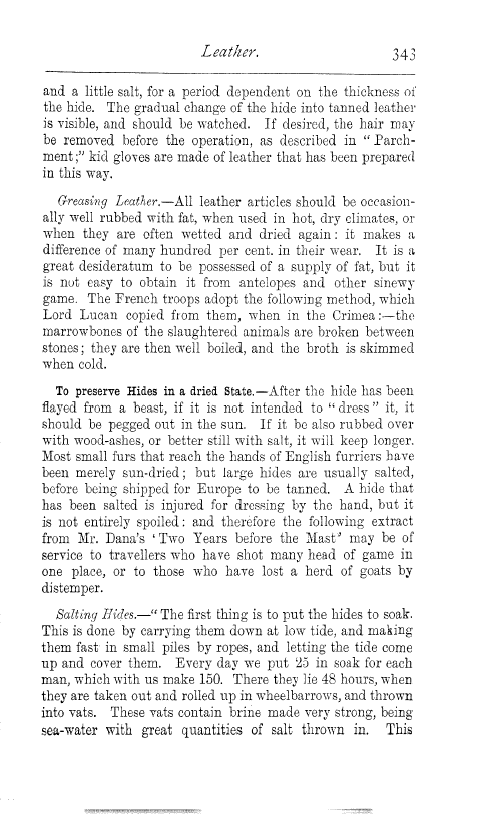| ||||||

OCR Rendition - approximateLeather. 343 and a little salt, for a period dependent on the thickness of the hide. The gradual change of the hide into tanned leather is visible, and should be watched. If desired, the hair may be removed before the operation, as described in " Parchment;" kid gloves are made of leather that has been prepared in this way. Greasing Leather.-All leather articles should be occasionally well rubbed with fat, when used in hot, dry climates, or when they are often wetted and dried again : it makes a difference of many hundred per cent. in their wear. It is a great desideratum to be possessed of a supply of fat, but it is nut easy to obtain it from antelopes and other sinewy game. The French troops adopt the following method, which Lord Lucan copied from them, when in the Crimea:-the marrowbones of the slaughtered animals are broken between stones; they are then well boiled, and the broth is skimmed when cold. To preserve Hides in a dried State.-After the hide has been flayed from a beast, if it is not intended to "dress" it, it should be pegged out in the sun. If it be also rubbed over with wood-ashes, or better still with salt, it will keep longer. Most small furs that reach the hands of English furriers have been merely sun-dried; but large hides are usually salted, before being shipped for Europe to be tanned. A hide that has been salted is injured for dressing by the hand, but it is not entirely spoiled : and therefore the following extract from Mr. Dana's `Two Years before the Mast' may be of service to travellers who have shot many head of game in one place, or to those who have lost a herd of goats by distemper. Salting Bides." The first thing is to put the hides to soak. This is done by carrying them down at low tide, and making them fast in small piles by ropes, and letting the tide come up and cover them. Every day we put 25 in soak for each man, which with us make 150. There they lie 48 hours, when they are taken out and rolled up in wheelbarrows, and thrown into vats. These vats contain brine made very strong, being sea-water with great quantities of salt thrown in. This |